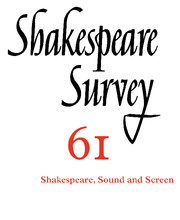Book contents
- Frontmatter
- Sarah Siddons, theatre voices and recorded memory
- Playing with Shakespeare’s play: Branagh’s Love’s Labour’s Lost
- Bottom and the gramophone: Media, class and comedy in Michael Hoffman’s A Midsummer Night's Dream
- Maurice Evans’s Richard II on Stage, Television and (Almost) Film
- Richard II on the Screen
- ‘Where Lies Your Text?’: Twelfth Night in American Sign Language Translation
- ‘This uncivil and unjust extent against thy peace’: Tim supple’s Twelfth Night, or what violence will
- ‘There’s no such thing’: nothing and nakedness in Polanski’s Macbeth
- Ghosts and mirrors: the gaze in film Hamlets
- ‘Ben, it’s a terrible thing to hate your mother’: mind control in Hamlet and The Manchurian Candidate
- Channelling the ghosts: the Wooster Group’s remediation of the 1964 Electronovision Hamlet
- Listening to Prospero’s Books
- Lend Me Your Ears: Sampling BBC Radio Shakespeare
- An Age of Kings and The ‘Normal American’
- Shakespeare and British Television
- A Local Habitation and a Name: Television and Shakespeare
- Paying attention in Shakespeare parody: from Tom Stoppard to YouTube
- Madagascan will: cinematic Shakespeares / transnational exchanges
- Still life? Anthropocentrism and the fly in Titus Andronicus and Volpone
- Riddling q1: Hamlet’s mill and the trickster
- ‘Speak, that I may see thee’: Shakespeare characters and common words
- Who do the people love?
- A Partial Theory of Original Practice
- Shakespeare Performances in England, 2007
- Professional Shakespeare productions in the British Isles, January–December 2006
- The Year's Contributions to Shakespearian Study 1 Critical studies
- 2 Shakespeare in performance
- 3a Editions and textual studies
- 3b Editions and textual studies: The RSC Complete Works
- Index to Volume 61
Maurice Evans’s Richard II on Stage, Television and (Almost) Film
Published online by Cambridge University Press: 28 November 2008
- Frontmatter
- Sarah Siddons, theatre voices and recorded memory
- Playing with Shakespeare’s play: Branagh’s Love’s Labour’s Lost
- Bottom and the gramophone: Media, class and comedy in Michael Hoffman’s A Midsummer Night's Dream
- Maurice Evans’s Richard II on Stage, Television and (Almost) Film
- Richard II on the Screen
- ‘Where Lies Your Text?’: Twelfth Night in American Sign Language Translation
- ‘This uncivil and unjust extent against thy peace’: Tim supple’s Twelfth Night, or what violence will
- ‘There’s no such thing’: nothing and nakedness in Polanski’s Macbeth
- Ghosts and mirrors: the gaze in film Hamlets
- ‘Ben, it’s a terrible thing to hate your mother’: mind control in Hamlet and The Manchurian Candidate
- Channelling the ghosts: the Wooster Group’s remediation of the 1964 Electronovision Hamlet
- Listening to Prospero’s Books
- Lend Me Your Ears: Sampling BBC Radio Shakespeare
- An Age of Kings and The ‘Normal American’
- Shakespeare and British Television
- A Local Habitation and a Name: Television and Shakespeare
- Paying attention in Shakespeare parody: from Tom Stoppard to YouTube
- Madagascan will: cinematic Shakespeares / transnational exchanges
- Still life? Anthropocentrism and the fly in Titus Andronicus and Volpone
- Riddling q1: Hamlet’s mill and the trickster
- ‘Speak, that I may see thee’: Shakespeare characters and common words
- Who do the people love?
- A Partial Theory of Original Practice
- Shakespeare Performances in England, 2007
- Professional Shakespeare productions in the British Isles, January–December 2006
- The Year's Contributions to Shakespearian Study 1 Critical studies
- 2 Shakespeare in performance
- 3a Editions and textual studies
- 3b Editions and textual studies: The RSC Complete Works
- Index to Volume 61
Summary
Unrealized Shakespeare films have their peculiar attraction: Max Reinhardt’s Twelfth Night, Laurence Olivier’s Macbeth and Michael Powell and Emeric Pressburger’s Tempest remain tantalizing possibilities, promising plans (some reaching an advanced stage of script development) that foundered for a variety of reasons, sometimes suggesting plausible additions to the roster of plays adapted for the screen . Richard II, though, seems an unlikely proposition for a movie, with its hero who remains unheroic until late in the day and its lack of a decisive battle to be fought or imbroglio to be untangled in the final half-hour. However, on one occasion at least a film of the play has seemed possible – or at least plausible enough to engage its proposers in a search for funds and resources.
On 21 March 1951 the New York Times columnist Sam Zolotow announced that ‘Stage Stars Plan Shakespeare Film. Maurice Evans and Margaret Webster Working on Movie of King Richard II ’. Evans and Webster, ‘considered tops in their respective Shakespearian departments as actor and director’, would ‘pool their know-how’ on a film that was due to begin photography (‘cameras are to start clicking’) in New York during the summer, and the executive producer of the project, budgeted at $1,500,000, was to be Filippo del Giudice, whose credits included (readers were reminded) Olivier’s films of Henry V and Hamlet and Noël Coward’s In Which We Serve. Webster was to fulfil the same function as Alan Dent on Olivier’s films – and Evans would supervise casting and ‘treatment’. Zolotow noted that ‘A Shakespearian film representation without the directorial services of Miss Webster was thought to be inconceivable by one observer.’ The team would adopt ‘an entirely different approach’ to that of Hollywood in filming Shakespeare, and ‘the screen transcription would follow the stage offering, meaning the predominant emphasis would be placed on the Bard’. More discussions were to be held, and Evans expected to be able to say more after Easter.
- Type
- Chapter
- Information
- Shakespeare Survey , pp. 36 - 56Publisher: Cambridge University PressPrint publication year: 2008



